There is a fundamental reason we perform preflight run-ups and engine checks before takeoff: It is a whole lot better to find problems at 1G, 0 feet AGL and 0 knots airspeed than it is while airborne. Making sure a powerplant will work as we intend before taking off is just good airmanship. A good run-up doesn’t mean everything is perfect, however, and we train for airborne engine problems, including full use of its controls and instruments.
Sometimes, though, the problems we’re looking for don’t reveal themselves when it is convenient for us, and we have to diagnose engine issues in the air. Urgently. And fly the airplane at the same time. It is not a comfortable experience. I was recently reminded of this while flying with a fellow pilot, whom I’ll call Roger, who simply needed some instrument dual in his Cessna 182.
“Did You Feel That Too?”
After a very clean and thorough run-up—Roger consistently impresses me with the best checklist discipline of any pilot I know—we took off to intercept the nearby VOR to do a few holds and then head outbound to log the requisite simulated instrument time. As we climbed, I briefly took control of the plane so my fellow pilot could don his hood. We both felt a momentary engine hesitation somewhere along the way, so brief it was barely noticeable. Maybe Roger bumped something while reaching for the ungainly plastic view-limiting hood.
Looking a bit like a dog returning from the veterinarian, Roger took back the controls, and we completed the climb to 7000 feet MSL with the engine sounding smooth. We did a few turns in the hold and proceeded outbound. Then things got interesting.
On reducing power and configuring for cruise, the engine started missing…a lot. We weren’t in actual clouds, but they were nearby and relative humidity was high. It was a cold winter day, and the previous day’s weather had been quite rainy and snowy. From inside his dog-collar-hood-of-shame, Roger shared a story from a few years earlier of a pilot in a rental 182 who did a precautionary landing due to carb ice. Cessna 182s of the vintage of Roger’s plane are notorious for forming carb ice, so we both agreed it was a reasonable suspect. He applied carb heat and, sure enough, as the carb-temperature gauge’s needle climbed from the yellow zone into the green, the engine smoothed out. We congratulated ourselves we had the problem licked.
Diagnosis
After a few minutes with carb heat in, we decided we could resume our trip to the next VOR. Upon taking the carb heat out, however, the engine started coughing again, even worse than before. For a moment, it made no sense. If it was carb ice, the dose of carb heat should have done the trick.
We discussed it briefly and decided perhaps we now had a fouled plug that was worsened by running over-rich with carb heat. So we adjusted the mixture settings. Repeatedly. But no red-knob position seemed to resolve the issue. Every time we returned to cruise settings, the engine was rough.
Finally, we did a magneto check. This is one of those tests where having an engine monitor is well worth the relatively small investment. On one magneto, the engine smoothed a bit. On the other, it got much rougher and the EGT on cylinder 3 dropped precipitously. Our final diagnosis: We had a spark plug issue on cylinder 3, likely a fouled plug. But a reasonable diagnosis that fit all the facts we had was only part of the challenge. We still needed an action plan.
Decision Time
As I write this now, in the comfort of my office chair, our diagnosis was pretty solid. Despite the data and positive diagnosis, confident is not the word I would use to describe the way I felt at the time. Even though we had excellent data telling us the number three cylinder had a bad spark plug, the one powered by a certain magneto, a rough engine while in flight is not something promoting confidence. Instead it provides a great deal of concern and skepticism. I also know that whenever you choose to ignore something unusual, whether it is in flight or on the ground, it starts a chain of events leading to an unforeseeable conclusion. I could imagine the opening statement of an NTSB report, “After experiencing a rough engine and determining it was a fouled spark plug, the pilots continued….” The best way to break the accident chain is stop any escalation of events.
We both agreed it was time to return to the airport. The engine wasn’t so rough it was losing power, but it was sufficiently rough we did not feel warm and fuzzy. We called the tower to let them know we would be returning to the airport with a rough engine. And, more importantly, we declared an emergency.
Technically, when coming into an airport, you follow normal procedures and get to pattern altitude to ensure smooth flow of traffic. But by declaring an emergency, we gave ourselves clearance to land as well as permission to stay as high as we wanted throughout the approach. As we did our 180 back to the airport, there was no rush to descend. We had no need to get to pattern altitude until we were 100 percent confident we were in gliding distance of the runway.
Planning For No Power
With the runway in gliding distance, all that was left was pulling power to descent. The engine was sufficiently rough that I questioned whether it would continue running at all after a power reduction. With no choice, and a great deal of trepidation, we started down…and everything went like clockwork. We landed a little longer than usual due to the higher starting point for our descent and naturally, the engine ran smoothly, as though any problems were all in our head.
It was amusing to have a fire truck escort us all the way to the hangar, but that’s usually what happens when you declare an emergency at a towered airport. All in all, it was a smart move. You are always better safe than dead, and the fire crews can use the practice to get the cobwebs off their fire-retardant suits.
In the end, our diagnosis was correct. The plugs needed to be changed. Roger and I agreed that while fouled plugs are a very minor thing, they can sure grab your attention in flight. Moreover, they provided us with some great experience on how to handle a real emergency. A rough-running cylinder 3 could just have easily been on the verge of eating or flinging a valve.
It was instructive to have experienced the event together and then afterward have the opportunity to reexamine it from a distance. When the engine was misbehaving, we tried to make it run smoothly. When it didn’t cooperate, and even got worse, we returned to the airport with an emergency declared in case the engine quit. Taking the most conservative approach to completing our flight was the right choice.
Are You Seriously Declaring An Emergency For A Fouled Plug?
When you aren’t 100-percent confident the engine will continue running, doesn’t it seem reasonable to just be the center of attention for a little bit? I learned this lesson in my Cub. I had just departed the airport, and was a few miles out, when the engine starting running very rough and losing power.
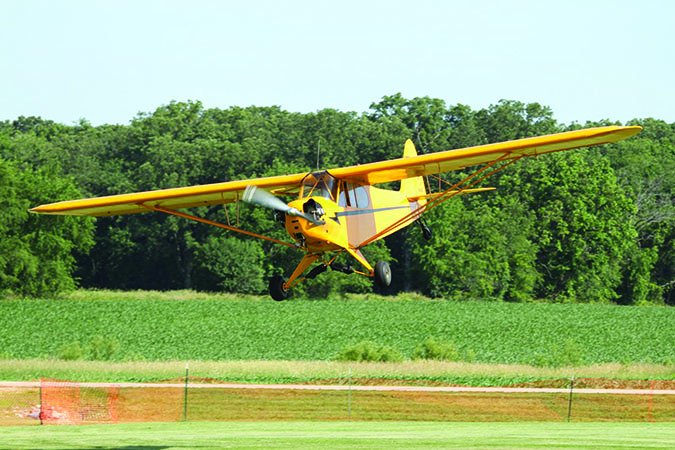
I tried carb heat, but was losing altitude. I called the tower, told them I had a rough engine, couldn’t hold altitude and would be returning to land in the opposite direction on the runway I just departed. That meant landing with a tailwind, which was the least of my problems because for a mile or so, I wasn’t sure I would make it back.
Despite my Cub’s power loss and inability to hold altitude, once I had the field made, I asked for a clearance. But I didn’t declare an emergency. That turned out to be one of the stupider decisions I have ever made, because when I looked at the other end of the runway, I saw a jet ready to take off.
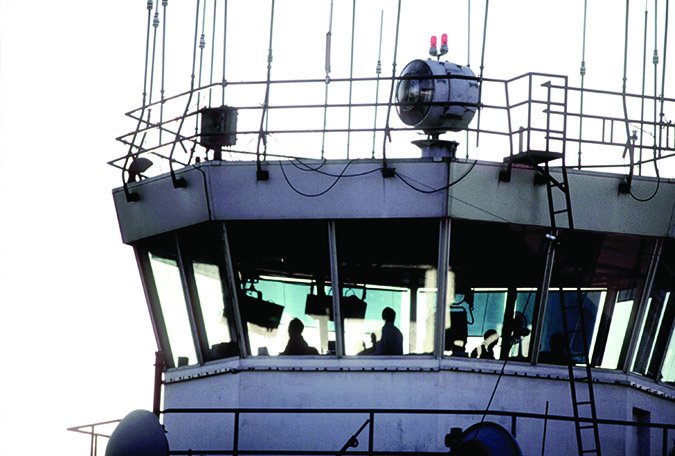
If the tower had cleared me to enter downwind to let the jet depart, I would have had to accept a plowed field rather than a runway. Fortunately, telling the tower I had a rough engine and needed to land opposite direction clued them in. However, after that experience, I won’t ever hesitate declaring an emergency again.
At a non-towered airport or en route, it may not matter if you declare an emergency over the radio—if no one hears you or can do anything about it, does it matter? There’s nothing in the FARs saying you have to declare an emergency to have one, just that you can deviate from them enough to resolve the emergency.
Preventing Lead Fouling
Avoiding prolonged low-power operation is key to avoiding lead fouling. The two coolest places inside the cylinder are the point of the spark ignition and the exhaust valve outlets, which creates the optimal conditions for vaporized lead oxides to condense as a liquid and cool to a solid. These conditions tend to occur at startup, descent and taxi after landing.
After startup, operate your engine at 1000-1200 rpm for the initial warmup period and not at idle speeds. The higher pressure helps rings seal, which reduces corrosive combustion byproducts going past the rings and into the oil. This reduces both corrosion problems and the amount of lead being pumped into the oil. At idle rpm, lead deposits are more likely to form because of the low combustion temperatures. This is where aggressive leaning on the ground can help. At taxi power settings, lean the mixture as much as you want—you won’t hurt the engine.
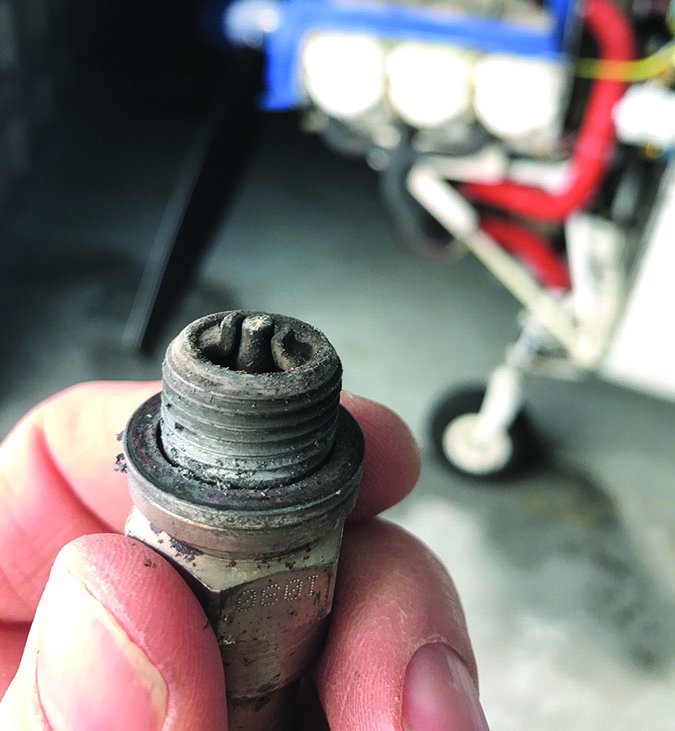
Rotate low spark plugs to top position, and remove, inspect and clean spark plugs that might be suspect. Lower plugs in an engine run dirtier than the top plugs. If the engine is running massive-electrode spark plugs like the one pictured above, changing to (admittedly more-expensive) fine-wire plugs may help cure lead-fouling problems.
Smooth application of power during takeoff reduces chances of lead fouling, which tends to make itself known at high power settings.
Engines that have been involved with long, low-power descents, or have taxied for some distance, may have low cylinder temperatures that lead to lead fouling.
Engine manufacturers often have specific recommendations, but it is a good practice after landing, and once the temperatures are stable, to briefly increase engine speeds to 1800-2000 rpm for a count of 10-20. This should be enough temperature rise to burn off lead deposits. Then reduce power to 1000-1200 rpm once again before shutdown using mixture control.
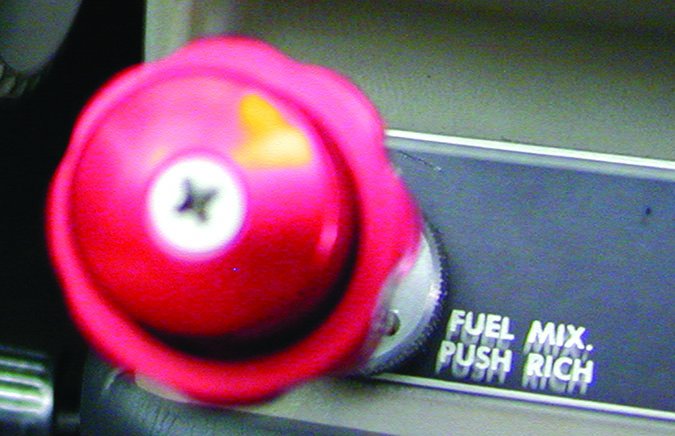
“Burning Off ” A Fouled Plug
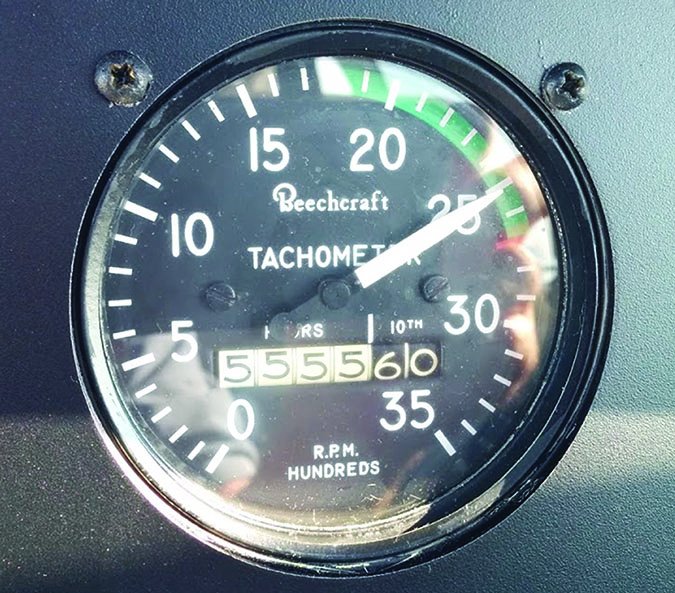
A lot of people these days are surprised to learn aviation gasoline contains lead. The current fuel, 100LL (or low-lead), in fact contains much less lead than the aviation gasoline it replaced, 100/130 octane (green gas). But engines designed for 80 octane fuel (red), which is no longer available in the U.S., and operated on 100LL (blue), can experience lead-fouled spark plugs. The Continental O-470 variant in Roger’s Skylane is one of those engines. So was the O-200 in the Cessna 150 I trained in
Primary students flying trainers back then were told to put the mixture control into the full-rich position and leave it there until shutting down, at least until they began to fly cross-countries. So lead-fouling was an occasional issue.
I don’t remember the first time an instructor taught me to “burn off” a fouled spark plug. But we likely had a slightly rough magneto during the run-up. With feet firmly on the brakes, the instructor boosted the engine’s rpm up to 2000, and slowly leaned the mixture. At the point the engine began to stumble, he stopped leaning and let it run like this for maybe 15 seconds. By then, it had smoothed out. Then he reduced rpm back to the checklist’s 1700 and repeated the mag check. Everything was good to go.
Leaning the mixture to near peak EGT at a high rpm—but not a high enough power setting to risk damage—increased both exhaust gas and cylinder head temperatures enough to melt the accumulated lead from the spark plug(s). If you’re running a relatively low-compression engine and occasionally have a less-than-perfect mag check, it might be due to lead fouling, and burning off the lead by increasing the cylinder’s temperature can help. — Jeb Burnside
This article originally appeared in the April 2017 issue of Aviation Safety magazine.
For more great content like this, subscribe to Aviation Safety




































Instructive, but I am surprised to learn that one of the coolest parts of the engine is “the exhaust valve outlets”, as all the hot gasses exit there? I’d have thought the inlet valve, with the air/gas mixture would be the cooler?
(This is not a criticism, it sounds like you know more than I do about these things!)
40 years ago I had memorized the POH, FAR/AIM, PHAK, Wolfgang, and even the Naval Aviator one. At least enough to get my ratings.
Man, I didn’t know what I didn’t know.
I wish I had read a plain language article like this. It seems most of us have to learn things the hard way, but this article would have made sense to me even in my bullet proof days.
Good Stuff!
There is an easier way to avoid lead fouling – use ethanol-free mogas. Available at thousands of locations found at pure-gas.org. Thanks to the great work by Todd Petersen, STCs are available for 80% of the piston-engine fleet. That we do not have this great lead-free fuel at our airports is a clear failure by airport owners, airport fuel suppliers and the aviation alphabets.
Kent, Exactly. That makes it tough on cross country flying. I can haul enough for local flights but have never found any lead-free mogas at small airfields. Too bad.
Kent M beat me to it: run lead-free mogas in those low compression trainers! It might even be cheaper.
Not needing much of any type gas in my Aeronca, I still used alcohol free Mogas for the 1200 hours I flew it. Plugs were always near perfect. My A&P would do nothing more than just maybe wipe off a bit of oil or some carbon soot. Mogas does leave more of that when burning. I realize Mogas may not be readily available for most and transporting to pour in a high wing not fun. But if you have it easily available, get a Mogas STC and give it a try. You’ll like it, and your plugs and valves will too, I think. Oh…I did always use that “snake oil” product MMO in the gas at the recommended amount.
Very good information and thoughts about declaring an emergency. The only issue with the information about lead fouling is you can’t “burn” off lead. You can clear a fouled plug with a run-up and lean mixture, but you can’t burn lead fouling off. The temperature needed to burn lead off is well above any acceptable exhaust gas temperature your engine will tolerate.
I’m curious – if the high RPM / lean mixture run-up isn’t “burning” off the lead deposits, how IS it clearing the fouled plug? (We had a 1971 182 that needed this procedure occasionally, and it always worked – whether it was “burning” off the lead, or getting rid of it some other way.)
You can burn other deposits off the plugs, but not the lead deposits. I know there are all kinds of opinions and old operating habits in aviation, but look at the science and you form your own opinion. You can prevent most lead deposits by following the proper procedures, but you are not going to burn it off. Here is some good information on prevention. https://www.shell.com/business-customers/aviation/aeroshell/knowledge-centre/technical-talk/techart-18-30071600.html
“The two coolest places inside the cylinder are the point of the spark ignition and the exhaust valve outlets, ..” I believe this is either a misprint/typo or incorrect. Both the “coolest” AND the “hottest” are the most hazardous…?? Maybe a rethink of all this is appropriate.
I believe overly-rich and reduced power operations are the major contributors and that leaning, besides saving fuel, also brings combustion temps up sufficiently that the bromides added to avgas can dissipate the Lead. Tricresyl phosphate (Alcor or similar) will also help…but the best thing we can do with current avgas is run high power settings in the leanest, safe conditions possible.
Nice article, thanks for writing it up! Remember, you can always run on one mag. Not that you want to continue a flight or anything, but if one is causing issues, turn it off and run on the other to get to an airport with services.
Mike Hart, I salute you for your decisions: 1) in-flight problem investigation and diagnosis, 2) decision to return to land in order to break the “…accident chain of events…”, 3) declaring an emergency, and 4) the decision to share this event and your thoughts with us. Your point about the “Monday Morning Quarterbacks” questioning “declaring” for a fouled spark plug deserves more emphasis: look at all the excuses that run through our minds as we think “declaring” is unnecessary.
A rough estimate of the sum of years of experience represented by just the few readers of your article would probably be more than a hundred years (I said the “sum”). And yet, experience does not seem to be the main driver of making good decisions. Our ability to make good in-flight decisions is not a function of our experience flying. In fact, the relationship between experience and the ability to make good flying decisions is being demonstrated to us daily as perhaps less important than we thought. Learning about the factors that contribute to good in-flight decision making is not about fear and paranoia, but rather about maturity, discipline, and a sense of responsibility – leadership qualities!
On a completely separate train of thought: alcohol free mogas works in our low compression engines, but there is one very significant point that we must be aware of! All gasoline – automotive or otherwise – is refined to ASTM standards that include octane ratings (or in the case of automotive gasoline, AKI or anti-knock index) and other values like Reid Vapor Pressure (RVP) as well. Avgas intentionally has a much reduced RVP (from 5.5 to 7.0 PSIA) while mogas uses seasonally adjusted higher RVP (from 7.0 to 19.0 PSIA). This RVP standard is met during fuel blending by the variable use of refining butanes and pentanes and can be a key factor in fuel vapor lock in aircraft at altitude. Just something we need to understand.
Yup, lean aggressively , especially at cold engine start to get the spark plugs hot enough to not allow the lead-bromide to condense on them.
Then taxi leaned so that if you advance the throttle, the engine will stumble, preventing you from taking off with the mixture leaned.
Also, when you swap the plugs top to bottom, do a resistance check on the plugs. Use a digital multimeter on the ‘2k’ resistance scale. Insert one probe down the plug where the wire connects and the other to the center electrode. You will have the scratch the probe on the electrode to scrape through the non-conductive deposits.
The resistance should be in the range of 1k [ 1,000 ohms], to about 2k – 3k.
Any higher resistance will cause the plug to not fire reliably and probably foul easily.
Older Champion plugs were more likely to have high resistance, but the newer plugs use a fused resistor, as Tempest does.
Great article and comments that clearly make the case for lead free Av gas. GAMI has a proven solution but can’t get the FAA’s go ahead. Paul Bertorelli reported, the FAA has made no discernible progress on approving G100. https://www.avweb.com/aviation-news/faa-no-discernible-progress-on-approving-g100ul-avgas/
Boy, I wish someone had showed me how to burn off the deposits when I owned the 150. Even running mogas when we could find it, the engine frequently loaded up with lead on the lower plugs. We finally changed to fine-wire plugs on the lowers and that made a huge difference. Thanks for the explanation!
And with 31 years of ATC experience, you were perfectly correct in declaring an emergency since your engine was acting up. I saw way too many pilots who were reticent to declare and emphasized that whenever I led a pilot-controller meeting. That’s what the services and procedures are for, getting you safely back on the ground! Rarely is any paperwork required other than the fire crew asking for a few particulars for their daily report.
Back in the early ’70s I worked in a Beechcraft shop that did contract maintenance for the US Army. Their piston engine planes were essentially Barons, Twin Bonanzas and Queen Airs. The Army dictated “full rich below 5000′” so the plugs would be so leaded up that they could not be cleaned even with a vibrating cleaner. This was in the days of 100/130 or even 115/145 fuel. Once when a Baron came in for a fuel cell change it was indeed fueled with purple gas. Not wanting to waste it I used it in my pickup and the tailpipe was well coated.
I generally don’t bother leaning my 182 on the ground but aggressively in cruise and descent and have no lead fouling issues.
In order to support others who read all this and share my view….
I take issue with trouble shooting a problem of this nature while in the local area on a training flight. My first action would have been to turn back towards the airport. If time allows you can troubleshoot on the way. Not trying to be difficult, but I think it’s an option that needs to mentioned.
My second issue is the use of Emergency. You hadn’t lost power so I believe a PAN PAN would have been more appropriate. You didn’t need regulatory relief for any of the accommodations you made to the situation, but it certainly could have turned that way in a flash. PAN PAN will still get you preferential treatment, and the system is ready for the emergency if it comes. People seem to forget about the PAN PAN option.
The Cub that couldn’t maintain altitude; yes that’s an emergency. But if you’re airplane is still running and you are able to control it, it isn’t an emergency. For sure, it’s not comfortable, but not an emergency.
A rough running engine is an emergency in my opinion because it affects airworthiness. I often lean during runup to clean the lead and carbon deposits off the plugs and it always works. A magneto check at 2,000 RPM on my Lycoming O-360-C1F tells me if leaning is needed. If so, then I lean until the engine RPM increases and then decreases. Enrich back to the peak lean point and run at 2,000 RPM for about 30 seconds. Then another mag check for roughness. If the engine runs smoothly, I’m ready to go. Otherwise, it’s time to check the plugs, magnetos or plug wires.
If you are unsure whether an inflight event is an emergency, it’s best to declare one to be on the safe side rather than causing confusion and uncertainty for yourself and ATC.
This spark plug and exhaust valve temperature thing feels like one of those half-truths that take on their own life. It is true that the combustion temperature does get hotter further away from the spark plugs, it is in fact what primarily drives the need for high octane fuels. The mixture in the cylinder is heated relatively uniformly during the compression stroke prior to combustion starting at the spark plugs. A combustion front then moves progressively out from the plugs to the furthest edges of the cylinder. The gasses behind the flame front are of course hot from the combustion and therefore expand. This expansion raises the pressure of the entire cylinder including the gasses ahead of the flame front that haven’t burned yet. This further compression of the unburned mixture increases its temperature before the flame front even reaches it. If it gets too hot before the flame front reaches it, it auto ignites resulting in knock. But even under normal conditions without knocking, since the combustion process away from the plugs starts at a higher temperature (and pressure), it also ends at a higher temperature.
Even so it feels like a stretch that this would result in cylinder head metal temperatures higher than the temperature of the spark plug tip – the spark plug is designed with a limited heat transfer path back to the threads in the head specifically to help regulate its temperature.
And as the piston moves down the combustion gasses expand and due work so of course they are also cooler by the time they exit the exhaust valves. But again the exhaust valves are going to run hotter than the cylinder head, otherwise we wouldn’t make them out of high temperature alloys. Heat flows FROM the exhaust valves TO the head, both through the seats and stems.
I would turn that premise completely on its head and ask, Why are the exhaust valves and the spark plugs the two hottest components in the engine?
The simplest answer is because they both steal energy from the Combustion gasses! Probably easiest to see in the case of the exhaust valve. Keep in mind that every internal part of the engine has a boundary layer (similar to the boundary layer on the skin of the plane) that in effect protects it from the hot combustion temperatures. The temperatures of the exhaust port are much lower than the back side of the valve. However, the flow along the ports is relatively smooth with a relatively thin boundary layer so it doesn’t interact heavily with the exhaust flow. Now notice how the valve stem looks like a cylinder in the middle of the flow and think about how thick and turbulent the boundary layer behind it is and how much higher the local heat transfer rate is. So where do you think the lead deposits are more likely to form?
Edit: Just in case it isn’t obvious I meant to say the skin temperature of the exhaust port WALLS are much lower than the surface temperature of the exhaust valves.
While Mogas certainly can help prevent lead build up, in Lycoming school you learn that it takes a min of 1200 rpm to have enough “heat” to scavenge lead and prevent build up. No amount of leaning on ground is going to give you that temp. I can verify it works as never had a fouled plug in my 20 years of Alon c90 ownership and plugs always were clean and perfect. Same with my C172 with H2AD engine. NO auto gas every used. And as mentioned, burning off to clear a plug is normally a event due to oil fouling. . If you have a 152 with long reach plugs, you know what lead is all about!